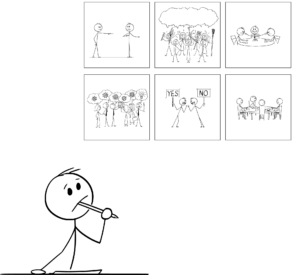ELEMENTS OF TRANSFORMATIVE DIALOGUE
A PATTERN LANGUAGE
This website offers a combination of guiding principles, skills, methods and tools for those using dialogue as a way to make decisions, reach agreements or resolve tension and conflict.
This site is however not only about political decision-making processes, but also about the challenges that arise when trying to work together for societal change. It also contains ideas for both those within the public sector and those working for change from outside it.
On Dialogue and Politics
Dialogue is an essential ingredient in any new form of politics. Whether we are speaking about a political system that needs to be changed, decisions governments and non-government organisations make or dealing with conflicts in a variety of arenas, dialogue is an essential ingredient of politics.
The problem is that the word dialogue is used very imprecisely. In fact, it is used for any kind of conversation and in some cases for communication which is entirely one-sided. We have added the word Transformative to indicate dialogue that makes a difference to those who are involved in it. Engaging in Transformative Dialogue changes the way people see a situation. It changes the way people view a conflict, a challenge, or simply a situation that needs attention. Seeing the world differently – if only in a minor way – is transformative.
Transformative Dialogue sometimes occurs by itself. It is a timeless art that has been practised for centuries. For many of us, however, it does not happen without some forethought, planning and skill. We can be skilled in dialogue to a greater or lesser degree.
This part of the LiFT project is a collection of building blocks for Transformative Dialogue. They consist of skills that can be learned and sharpened. You will also find aspects of a mindset or attitude – which we call meta-skills. An aspect of the mindset for Transformative Dialogue is a frame or a process logic. It is a simple sequence that can be adapted to manage a variety of different situations. Finally, there are some methods – which are really a combination of a skillset and a mindset that could be helpful in specific situations.
We call the building blocks patterns – not in the sense of a repeating sequence – but rather as a re-usable solution to a typical problem or challenge. A more appropriate picture would be that of a pattern used for making an item of clothing. It can be scaled up or down. It can be used to craft the item from different kinds of cloth. In the same way, the patterns on the website can be used for small or large dialogue processes and they can be used in ways that suit the user’s style and purpose. A pattern for transformative dialogue should always contribute to improving the quality of the conversation. Many patterns can be combined, in the same way that words are combined to form sentences and a language
Elements or Patterns
The patterns on this website are components of a dialogic way of thinking and acting. They are lessons practitioners and participants in dialogue have gleaned from both successful and unsuccessful processes. You can combine the patterns in different ways to meet various challenges in the same way that words are combined to make sentences that make up a language.
If you are curious about design patterns and how to use them, or if you want to know more about why we distinguish different levels, read more here.
How to use this Website
You can choose one of two ways to start:
- The first is to familiarise yourself with a palette of skills and methods as well as a basic approach to and logic for using dialogue in the process of change.
- The second is to identify a scenario that is significantly close to a challenge you face and there find and explore some ideas as to how to use and combine the patterns.
You can start at either end. There are links between patterns and links between the patterns and scenarios which you can explore.
YOUR PALETTE
Here you will find the basic elements that will allow you to deal with situations that arise irrespective of whether it is on a personal, interpersonal, group or society level.
SCENARIOS
Here you will find a number of typical scenarios or challenges faced by practitioners and decision-makers who wish to use dialogue in order to make better decisions or to resolve problems that arise in different contexts where collaboration is required.



